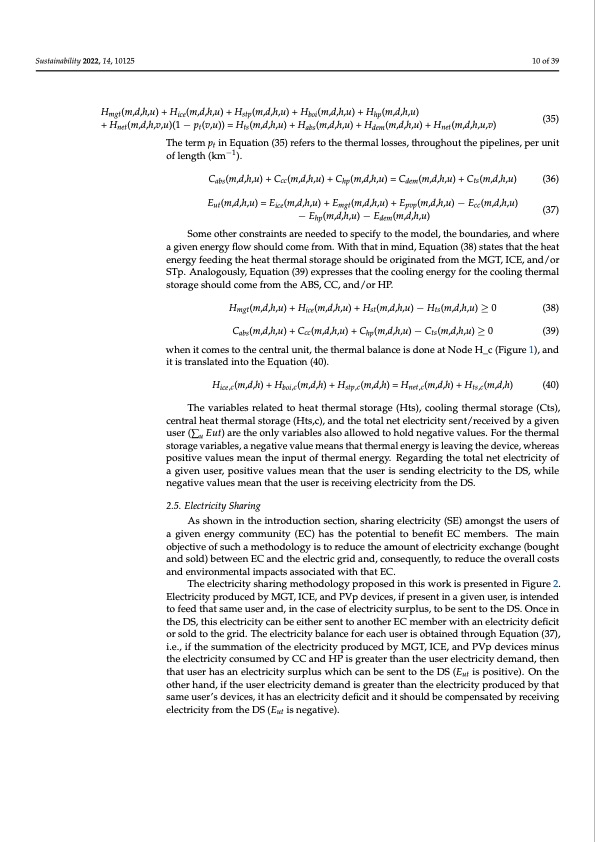
PDF Publication Title:
Text from PDF Page: 010
Sustainability 2022, 14, 10125 10 of 39 Hmgt(m,d,h,u) + Hice(m,d,h,u) + Hstp(m,d,h,u) + Hboi(m,d,h,u) + Hhp(m,d,h,u) + Hnet(m,d,h,v,u)(1 − pt(v,u)) = Hts(m,d,h,u) + Habs(m,d,h,u) + Hdem(m,d,h,u) + Hnet(m,d,h,u,v) (35) The term pt in Equation (35) refers to the thermal losses, throughout the pipelines, per unit of length (km−1). Cabs(m,d,h,u) + Ccc(m,d,h,u) + Chp(m,d,h,u) = Cdem(m,d,h,u) + Cts(m,d,h,u) (36) Eut(m,d,h,u) = Eice(m,d,h,u) + Emgt(m,d,h,u) + Epvp(m,d,h,u) − Ecc(m,d,h,u) − Ehp(m,d,h,u) − Edem(m,d,h,u) (37) Some other constraints are needed to specify to the model, the boundaries, and where a given energy flow should come from. With that in mind, Equation (38) states that the heat energy feeding the heat thermal storage should be originated from the MGT, ICE, and/or STp. Analogously, Equation (39) expresses that the cooling energy for the cooling thermal storage should come from the ABS, CC, and/or HP. Hmgt(m,d,h,u) + Hice(m,d,h,u) + Hst(m,d,h,u) − Hts(m,d,h,u) ≥ 0 (38) Cabs(m,d,h,u) + Ccc(m,d,h,u) + Chp(m,d,h,u) − Cts(m,d,h,u) ≥ 0 (39) when it comes to the central unit, the thermal balance is done at Node H_c (Figure 1), and it is translated into the Equation (40). Hice,c(m,d,h) + Hboi,c(m,d,h) + Hstp,c(m,d,h) = Hnet,c(m,d,h) + Hts,c(m,d,h) (40) The variables related to heat thermal storage (Hts), cooling thermal storage (Cts), central heat thermal storage (Hts,c), and the total net electricity sent/received by a given user (∑u Eut) are the only variables also allowed to hold negative values. For the thermal storage variables, a negative value means that thermal energy is leaving the device, whereas positive values mean the input of thermal energy. Regarding the total net electricity of a given user, positive values mean that the user is sending electricity to the DS, while negative values mean that the user is receiving electricity from the DS. 2.5. Electricity Sharing As shown in the introduction section, sharing electricity (SE) amongst the users of a given energy community (EC) has the potential to benefit EC members. The main objective of such a methodology is to reduce the amount of electricity exchange (bought and sold) between EC and the electric grid and, consequently, to reduce the overall costs and environmental impacts associated with that EC. The electricity sharing methodology proposed in this work is presented in Figure 2. Electricity produced by MGT, ICE, and PVp devices, if present in a given user, is intended to feed that same user and, in the case of electricity surplus, to be sent to the DS. Once in the DS, this electricity can be either sent to another EC member with an electricity deficit or sold to the grid. The electricity balance for each user is obtained through Equation (37), i.e., if the summation of the electricity produced by MGT, ICE, and PVp devices minus the electricity consumed by CC and HP is greater than the user electricity demand, then that user has an electricity surplus which can be sent to the DS (Eut is positive). On the other hand, if the user electricity demand is greater than the electricity produced by that same user’s devices, it has an electricity deficit and it should be compensated by receiving electricity from the DS (Eut is negative).PDF Image | Optimal Sharing Electricity and Thermal Energy

PDF Search Title:
Optimal Sharing Electricity and Thermal EnergyOriginal File Name Searched:
sustainability-14-10125-v2.pdfDIY PDF Search: Google It | Yahoo | Bing
Turbine and System Plans CAD CAM: Special for this month, any plans are $10,000 for complete Cad/Cam blueprints. License is for one build. Try before you buy a production license. More Info
Waste Heat Power Technology: Organic Rankine Cycle uses waste heat to make electricity, shaft horsepower and cooling. More Info
All Turbine and System Products: Infinity Turbine ORD systems, turbine generator sets, build plans and more to use your waste heat from 30C to 100C. More Info
CO2 Phase Change Demonstrator: CO2 goes supercritical at 30 C. This is a experimental platform which you can use to demonstrate phase change with low heat. Includes integration area for small CO2 turbine, static generator, and more. This can also be used for a GTL Gas to Liquids experimental platform. More Info
Introducing the Infinity Turbine Products Infinity Turbine develops and builds systems for making power from waste heat. It also is working on innovative strategies for storing, making, and deploying energy. More Info
Need Strategy? Use our Consulting and analyst services Infinity Turbine LLC is pleased to announce its consulting and analyst services. We have worked in the renewable energy industry as a researcher, developing sales and markets, along with may inventions and innovations. More Info
Made in USA with Global Energy Millennial Web Engine These pages were made with the Global Energy Web PDF Engine using Filemaker (Claris) software.
Sand Battery Sand and Paraffin for TES Thermo Energy Storage More Info
| CONTACT TEL: 608-238-6001 Email: greg@infinityturbine.com | RSS | AMP |